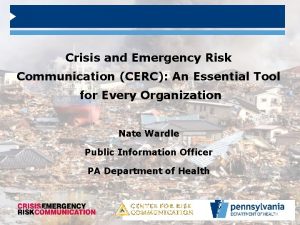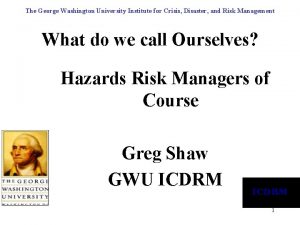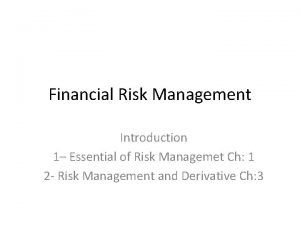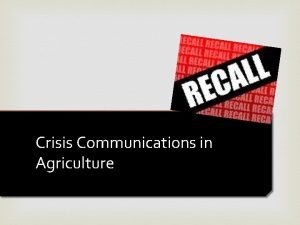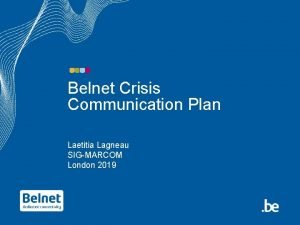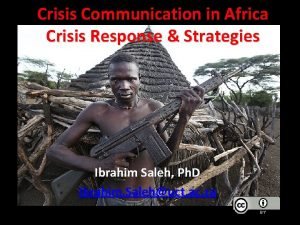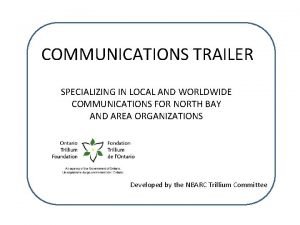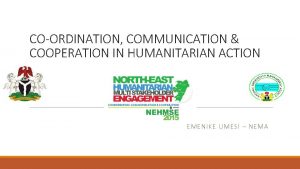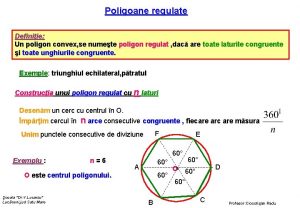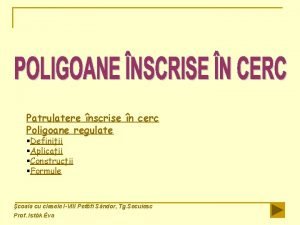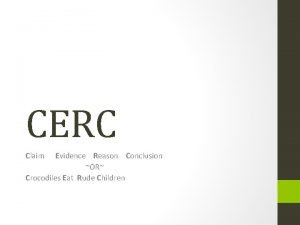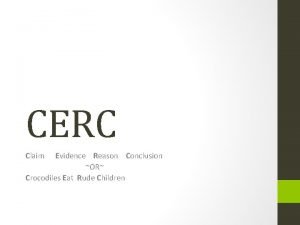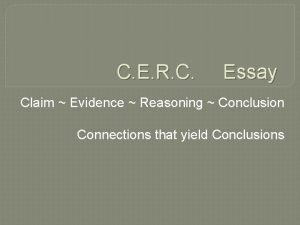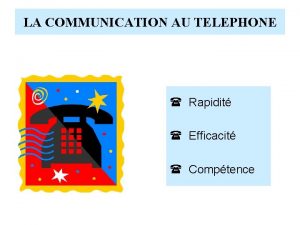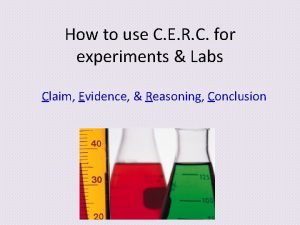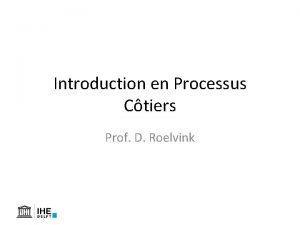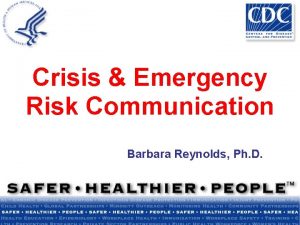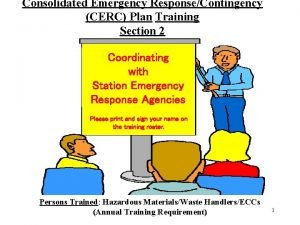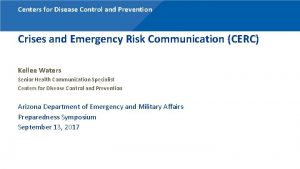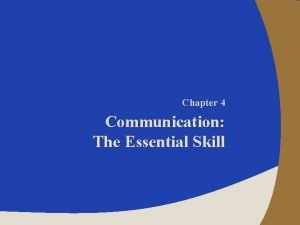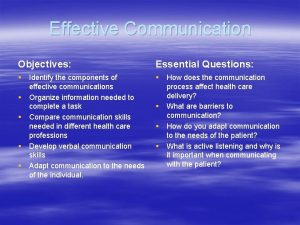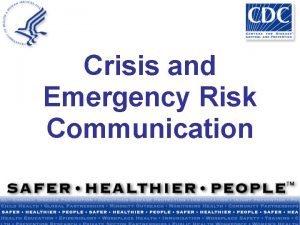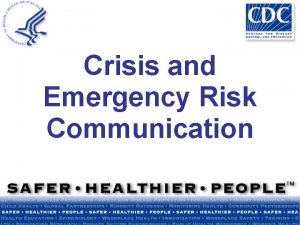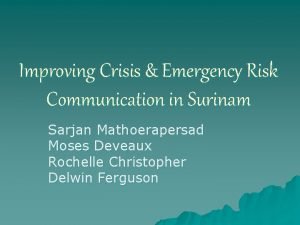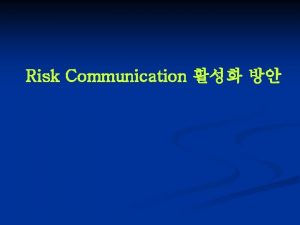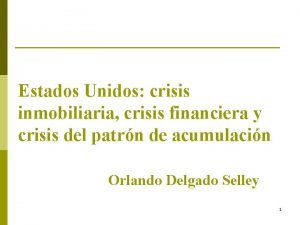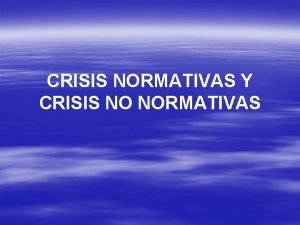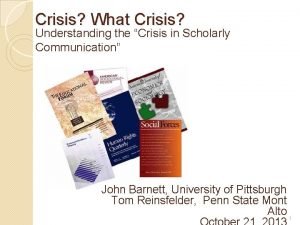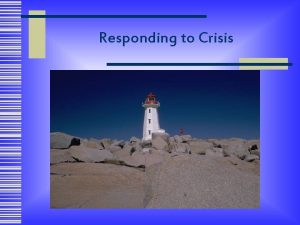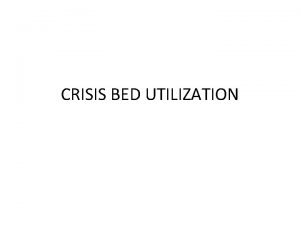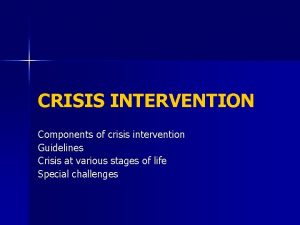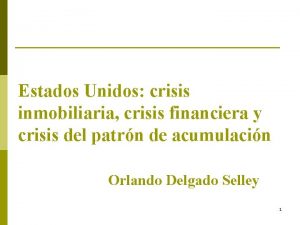Crisis and Emergency Risk Communication CERC An Essential
















































- Slides: 48

Crisis and Emergency Risk Communication (CERC): An Essential Tool for Every Organization Nate Wardle Public Information Officer PA Department of Health

Who is CERC for? • CERC training is essential for: Emergency managers Law enforcement First responders Health professionals Business leaders Local, county and state officials

Purpose • CERC principles can help you provide the public with information to make the best decisions within incredibly challenging time constraints and to accept the imperfect nature of choice. http: //www. rcfedisasterhelp. com/

Part 1: Introduction to CERC • Overview CERC principles Communicating during a crisis Crisis communication lifecycle https: //www. smu. edu. sg/perspectives/2015/01/28/c risis-communication-age-social-media

Six CERC principles • • • Be first Be right Be credible Express empathy Promote action Show respect

Be first • Crises are time-sensitive • The first source of information is often preferred

Be right • Accuracy establishes credibility • Information should include what is known, what is not known and what is being done to fill in the gaps

Be credible • Honesty should not be compromised. Intention toward the receiver Expertise Trustworthiness

Express empathy • Suffering should be acknowledged in words • Build trust and rapport

Promote action • • Giving people meaningful things to do calms anxiety Promotes a restored sense of control Image credit: https: //commons. wikimedia. org/w/index. php? curid=8069377

Show respect • • Important when people feel vulnerable Promotes cooperation and rapport Image credit: https: //commons. wikimedia. org/w/index. php? curid=8224401

Communicating in a crisis • During a public health crisis, the public is concerned about: Gaining wanted facts Empowered decision-making Involvement as a participant, not a spectator Providing watch over resource allocation Recovery and preserving well-being and normalcy • CERC is a set of tools to help you gain and keep the public’s trust.

Crisis communication lifecycle Initial Precrisis ▪ ▪ ▪ Prepare Foster alliances Develop consensus recommend ations Test message Evaluate plans ▪ ▪ ▪ Express empathy Provide simple risk explanations Establish credibility Recommend actions Commit to stakeholders Maintenance ▪ ▪ ▪ Further explain risk by population groups Provide more background Gain support for response Empower risk/benefit decisionmaking Capture feedback for analysis ▪ ▪ Resolution Educate a primed public for future crises Examine problems Gain support for policy and resources Promote your organization’s role Evaluation ▪ ▪ Capture lessons learned Develop an event SWOT Improve plan Return to precrisis planning

Part 2: Psychology of a crisis • • Psychological effects of a crisis Communication in a crisis Perception of risk CERC in action https: //www. psychologytoday. com/blog/fulfillment-any -age/201410/how-deal-someone-whos-always-lookingcrisis

Psychology of a crisis • What do people feel when a disaster looms or as it occurs? • There are many psychological barriers to communication during a crisis: Denial Fear, anxiety, confusion, dread Hopelessness or helplessness People rarely panic

CERC and negative behaviors • CERC can help address negative behaviors during a crisis such as: • Negative vicarious rehearsal • Denial • Stigmatization • Fear • Optimistic bias • Self-destructive behaviors • Hopelessness and helplessness • Reliance on special relationships for favors and treatment • Multiple Unexplained Physical Symptoms (MUPS) • Post-Traumatic Stress Disorder (PTSD)

Communication&emergencies • In a catastrophic event, communication is different. • Affected people: Take in information differently Process information differently Act on information differently Image credit: https: //commons. wikimedia. org/w/index. php? curid=16424967

Communicating differently • During a crisis people take in information by: Simplifying messages Holding onto current beliefs Looking for additional information and opinions Believing the first message Image credit: https: //commons. wikimedia. org/w/index. php? curid=22743578

Risk perception • Risks are perceived differently and not accepted equally Controlled personally vs. controlled by others Familiar vs. exotic Natural vs. manmade Fairly vs. unfairly distributed Trusted institutions vs. mistrusted institutions Affecting adults vs. affecting children

Hazard and Outrage • Hazard: Scientific measure • Outrage: Emotional measure Risk = Hazard + Outrage

Hazard vs. Outrage - Visually

Risk attributes of a crisis • Directions: For each of the following scenarios, select one box to indicate the combination of hazard perceived by officials and (emotional response) outrage you think the general public will experience. • Scenario 1: Pandemic influenza in the United States High Hazard High Outrage Low Hazard

Risk attributes of a crisis 2 • Scenario 2: Hepatitis A outbreak among children resulting from eating illegally imported strawberries as a part of a USDA-supported school lunch. High Hazard High Outrage Low Hazard

Risk attributes of a crisis 3 • Scenario 3: A massive snowstorm shuts down roadways and leaves thousands without power. High Hazard High Outrage Low Hazard

CERC in action • • • Allow people the right to feel fear Don’t over-reassure Acknowledge uncertainty Give people meaningful things to do Under-promise and over-deliver When the news is good, state continued concern before stating reassuring updates https: //www. oneoc. org/volunteers/disaster-volunteering

Rules of risk communication • Accept and involve the public as a legitimate partner. • Listen to your audiences. • Be honest, frank and open. • Coordinate and collaborate with other credible sources. • Meet the needs of the media. • Speak clearly, with compassion and empathy. • Plan carefully and evaluate performance. https: //www. hsph. harvard. edu/ecpe/programs/a pplied-risk-communication-for-the-21 st-century/

Part 3: Know your audience • Overview Understanding your audience How culture impacts your audience Non-verbal communication Making facts work in your message http: //medicine. hofstra. edu/about/news_photos_press. html

Understanding your audience • The public will judge your message by its content, messenger, and method of delivery. • You can better understand the needs of your audience if you understand: their relationship to the incident their psychological differences their demographic differences • Remember: Audience needs and interests will change as the crisis evolves.

Audience relationship to the event

Culture • Culture: Definition: Groups who share a common: Identity Set of beliefs, values and behaviors Definition of boundaries (e. g. , what is right and wrong, proper or improper) Definition of how work and life should be conducted.

Non-Verbal Communication • • Provides up to 75 percent of message Overrides verbal content Intensely and quickly noticed Interpreted negatively

Non-verbal communication • • • Eyes (Facial Expressions) Posture Hands Dress (Appearance) Voice

Making facts work in your message • • • Be concise and focused Include only relevant information Give action steps in positives Repeat the message Use personal pronouns when discussing the organization Promise only what can be delivered Use plain language Avoid speculation Avoid humor

Message importance

Part 4: Using messages • Important methods: 27 words, 9 seconds, 3 messages Rule of 3 Primary/recency • Templates for communication: 1 N = 3 P – One negative equals three positives Authority, Logic, Emotion (ALE) Know, Do, Go (KDG)

Three key points Crisis and Emergency Risk Communication is a sciencebased discipline High concern situations change the rules for effective communication The key to CERC success is anticipation, preparation, and practice

Goals of CERC Inform and Educate Build or Gain Repair Agreement Trust

Principles of CERC • When people are fearful, stressed or upset, they typically: (1)…want to know that you care before they care what you know (CCO template) (2)…have difficulty hearing, understanding, and remembering information (27/9/3 template) (3)…focus more on negative information than on positive information (1 N = 3 P template) (4)…focus most on what they hear first and last. (P/R template) 38

Tools of CERC • • R 3 template P/R template 27/9/3 template CCO template 1 N=3 P template AGL-4 template KDK template

Message Maps Risk Communication Tool: Message Map Key Message 1 (3 words approx. ) 40 Stakeholder: Question or Concern: Key Message 2 (3 words approx. ) Key Message 3 (3 words approx. ) Copyright, Dr. V Covelo, Center for Change/High Impact Communication

Zika Message Map Message : Question: What can people do to protect May 2014 themselves from mosquitoes carrying Zika? Key Message “Remove Standing Water” 1. 1 1. 2 1. 3 Puddles Flower Pots, Bird Baths, Old Tires Cup/Capful of Water Copyright Dr. V. Covelo, Center for Change/Ri Key Message “Wear Protective Clothing” 2. 1 2. 2 2. 3 Key Message “Use Insect Repellent” Long Sleeves 3. 1 Long Pants 3. 2 DEET 23% Medical 41 HERC v 3. 1 Copyright, Dusk and Dr. V Covelo, Center 3. 3 for Change/High Impact Communication Research Dawn

Areas of application • High concern/risk situations Shootings, scandals Missed deadline/project Sexual abuse delays Controversial • Organizational change approvals/permissions Merger/downsizing/rapid Protests/personnel growth decisions Layoffs/funding cuts Change in policy, mission • Crises, emergencies and disasters Accidents Natural hazards

APP strategic template • Anticipate Issues, stakeholders, questions and concerns • Prepare Messages, messengers and means of communication • Practice, practice!

Seven step strategy 1. Identify important high concern communication scenarios 2. Identify key stakeholders (audiences) 3. Identify stakeholder questions and concerns 4. Develop key messages 5. Develop supporting information 6. Coordinate and test messages with stakeholders and partners 7. Plan for delivery “Most of the concerns and questions of upset or concerned people can be predicted in advance. ” Mayor Rudolph Giuliani, 1995

Frequently asked questions • 77 Questions Commonly Asked by Journalists During an Emergency or Crisis https: //www. nyfa. edu/student-resources/top-12 -influential-journalists-today/

Three key points Crisis and Emergency Risk Communication is a sciencebased discipline High concern situations change the rules for effective communication The key to CERC success is anticipation, preparation, and practice

Take-away quote “If I had all day to cut down a large tree, I would use most of the day to sharpen my axe. ” Abraham Lincoln, 1859 https: //www. whitehouse. gov/1600/presidents/abrahamlincoln

Contact • nwardle@pa. gov • Facebook – Nate Wardle • Twitter - @natewardle
 Crisis and emergency risk communication
Crisis and emergency risk communication Market risk assessment
Market risk assessment Acetylcholine crisis
Acetylcholine crisis Institute for crisis disaster and risk management
Institute for crisis disaster and risk management Characteristics of lipids
Characteristics of lipids Ladder up risk assessment crisis text line
Ladder up risk assessment crisis text line What is financial risk 1
What is financial risk 1 Crisis communications working group
Crisis communications working group Crisis communication lecture
Crisis communication lecture Communicaiton plan
Communicaiton plan Crisis communication skills
Crisis communication skills Crisis communication model
Crisis communication model Residual risk and secondary risk pmp
Residual risk and secondary risk pmp Business vs financial risk
Business vs financial risk Relative risk
Relative risk Relative risk
Relative risk Ham radio communications trailers
Ham radio communications trailers Communication coordination cooperation during the emergency
Communication coordination cooperation during the emergency Cerc paca
Cerc paca Poligon regulat cu 11 laturi
Poligon regulat cu 11 laturi Fie ac perpendicular pe bd
Fie ac perpendicular pe bd Cercuri tangente interioare
Cercuri tangente interioare Cerc pedagogic valcea
Cerc pedagogic valcea Cerc writing
Cerc writing Cerc paragraph
Cerc paragraph Cerc paragraph
Cerc paragraph Claim evidence reasoning essay
Claim evidence reasoning essay Methode cerc
Methode cerc Begining transition words
Begining transition words Méthode croc téléphone
Méthode croc téléphone Cerc example
Cerc example Formule cerc
Formule cerc Starcc principle
Starcc principle Cerc plan
Cerc plan Six principles of cerc
Six principles of cerc Proces verbal cerc pedagogic
Proces verbal cerc pedagogic Cerc registradora
Cerc registradora Importance of communication
Importance of communication Essential questions about communication
Essential questions about communication Risk projection attempts to rate each risk in two ways
Risk projection attempts to rate each risk in two ways Risk avoidance insurance
Risk avoidance insurance Relative risk calculation
Relative risk calculation Inherent risks examples
Inherent risks examples Absolute risk vs relative risk
Absolute risk vs relative risk Activity sheet 2: stock market calculations answer key
Activity sheet 2: stock market calculations answer key Risk classification systems
Risk classification systems Risk financing transfer adalah
Risk financing transfer adalah The biggest risk is not taking any risk
The biggest risk is not taking any risk Key risk indicators financial risk management
Key risk indicators financial risk management
